C语言函数大全(m开头)
- 格式:doc
- 大小:36.50 KB
- 文档页数:4
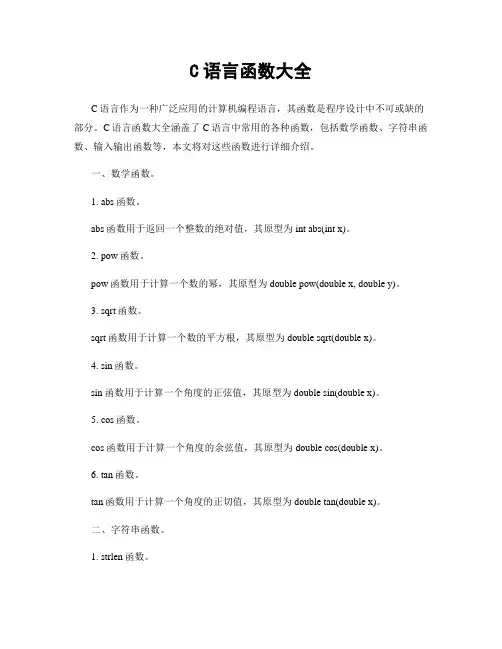
C语言函数大全C语言作为一种广泛应用的计算机编程语言,其函数是程序设计中不可或缺的部分。
C语言函数大全涵盖了C语言中常用的各种函数,包括数学函数、字符串函数、输入输出函数等,本文将对这些函数进行详细介绍。
一、数学函数。
1. abs函数。
abs函数用于返回一个整数的绝对值,其原型为int abs(int x)。
2. pow函数。
pow函数用于计算一个数的幂,其原型为double pow(double x, double y)。
3. sqrt函数。
sqrt函数用于计算一个数的平方根,其原型为double sqrt(double x)。
4. sin函数。
sin函数用于计算一个角度的正弦值,其原型为double sin(double x)。
5. cos函数。
cos函数用于计算一个角度的余弦值,其原型为double cos(double x)。
6. tan函数。
tan函数用于计算一个角度的正切值,其原型为double tan(double x)。
二、字符串函数。
1. strlen函数。
strlen函数用于返回一个字符串的长度,其原型为size_t strlen(const char s)。
2. strcpy函数。
strcpy函数用于将一个字符串复制到另一个字符串中,其原型为charstrcpy(char dest, const char src)。
3. strcat函数。
strcat函数用于将一个字符串追加到另一个字符串的末尾,其原型为char strcat(char dest, const char src)。
4. strcmp函数。
strcmp函数用于比较两个字符串,其原型为int strcmp(const char s1, const char s2)。
5. strchr函数。
strchr函数用于在一个字符串中查找指定字符的位置,其原型为charstrchr(const char s, int c)。

常用数学函数abs(计算整型数的绝对值)相关函数labs, fabs表头文件#include<stdlib.h>定义函数int abs (int j)函数说明abs()用来计算参数j的绝对值,然后将结果返回。
返回值返回参数j的绝对值结果。
范例#ingclude <stdlib.h>main(){int ansert;answer = abs(-12);printf("|-12| = %d\n", answer);}执行|-12| = 12acos(取反余弦函数数值)相关函数asin , atan , atan2 , cos , sin , tan表头文件#include <math.h>定义函数double acos (double x);函数说明acos()用来计算参数x的反余弦值,然后将结果返回。
参数x范围为-1至1之间,超过此范围则会失败。
返回值返回0至PI之间的计算结果,单位为弧度,在函数库中角度均以弧度来表示。
错误代码EDOM参数x超出范围。
附加说明使用GCC编译时请加入-lm。
范例#include <math.h>main (){double angle;angle = acos(0.5);printf("angle = %f\n", angle);}执行angle = 1.047198asin(取反正弦函数值)相关函数acos , atan , atan2 , cos , sin , tan表头文件#include <math.h>定义函数double asin (double x)函数说明asin()用来计算参数x的反正弦值,然后将结果返回。
参数x范围为-1至1之间,超过此范围则会失败。
返回值返回-PI/2之PI/2之间的计算结果。
错误代码EDOM参数x超出范围附加说明使用GCC编译时请加入-lm范例#include<math.h>main(){double angle;angle = asin (0.5);printf("angle = %f\n",angle);}执行angle = 0.523599atan(取反正切函数值)相关函数acos,asin,atan2,cos,sin,tan表头文件#include<math.h>定义函数double atan(double x);函数说明atan()用来计算参数x的反正切值,然后将结果返回。
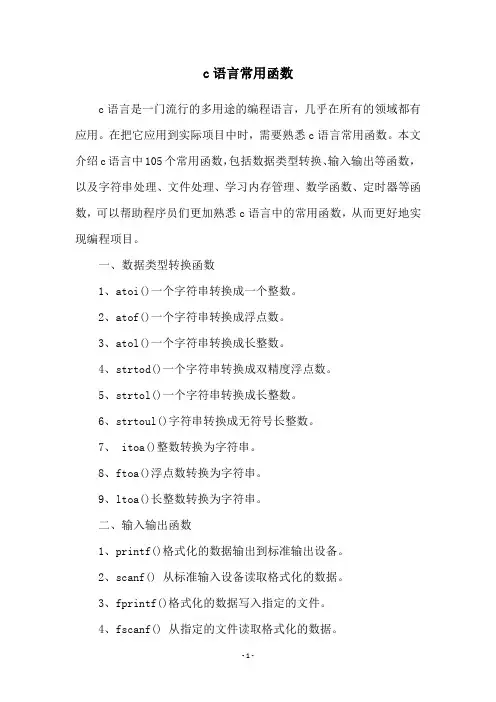
c语言常用函数c语言是一门流行的多用途的编程语言,几乎在所有的领域都有应用。
在把它应用到实际项目中时,需要熟悉c语言常用函数。
本文介绍c语言中105个常用函数,包括数据类型转换、输入输出等函数,以及字符串处理、文件处理、学习内存管理、数学函数、定时器等函数,可以帮助程序员们更加熟悉c语言中的常用函数,从而更好地实现编程项目。
一、数据类型转换函数1、atoi()一个字符串转换成一个整数。
2、atof()一个字符串转换成浮点数。
3、atol()一个字符串转换成长整数。
4、strtod()一个字符串转换成双精度浮点数。
5、strtol()一个字符串转换成长整数。
6、strtoul()字符串转换成无符号长整数。
7、 itoa()整数转换为字符串。
8、ftoa()浮点数转换为字符串。
9、ltoa()长整数转换为字符串。
二、输入输出函数1、printf()格式化的数据输出到标准输出设备。
2、scanf() 从标准输入设备读取格式化的数据。
3、fprintf()格式化的数据写入指定的文件。
4、fscanf() 从指定的文件读取格式化的数据。
5、sprintf()格式化的数据存储到字符串变量中。
6、sscanf() 从字符串变量中读取格式化的数据。
三、字符串处理函数1、strlen()算字符串长度。
2、strcpy() 从源字符串复制到目标字符串。
3、strcat()源字符串添加到目标字符串的末尾。
4、strcmp()较两个字符串。
5、strncpy() 从源字符串复制到目标字符串,长度不超过指定的长度。
6、strncat()源字符串添加到目标字符串的末尾,长度不超过指定的长度。
7、strncmp()较两个字符串,长度不超过指定的长度。
8、strstr()到第一个字符串中出现第二个字符串的位置。
9、strchr()到第一个字符串中出现字符c的位置。
10、strrchr()到第一个字符串中最后一次出现字符c的位置。
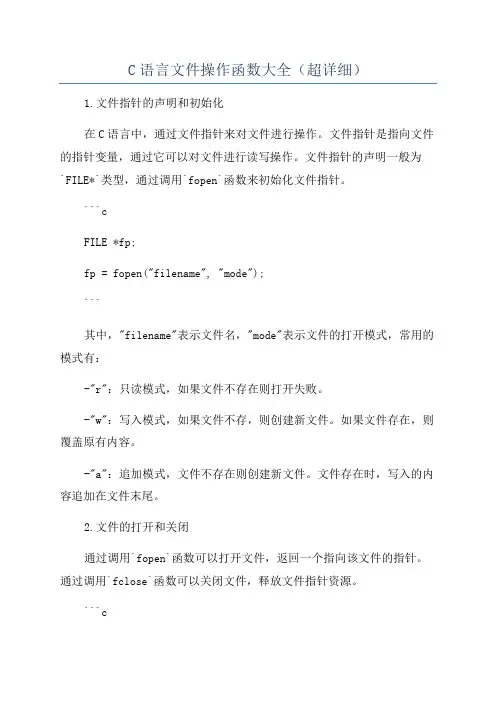
C语言文件操作函数大全(超详细)1.文件指针的声明和初始化在C语言中,通过文件指针来对文件进行操作。
文件指针是指向文件的指针变量,通过它可以对文件进行读写操作。
文件指针的声明一般为`FILE*`类型,通过调用`fopen`函数来初始化文件指针。
```cFILE *fp;fp = fopen("filename", "mode");```其中,"filename"表示文件名,"mode"表示文件的打开模式,常用的模式有:-"r":只读模式,如果文件不存在则打开失败。
-"w":写入模式,如果文件不存,则创建新文件。
如果文件存在,则覆盖原有内容。
-"a":追加模式,文件不存在则创建新文件。
文件存在时,写入的内容追加在文件末尾。
2.文件的打开和关闭通过调用`fopen`函数可以打开文件,返回一个指向该文件的指针。
通过调用`fclose`函数可以关闭文件,释放文件指针资源。
```cFILE *fp;fp = fopen("filename", "mode");//操作文件fclose(fp);```3.文件的读取通过调用`fscanf`或`fgets`函数可以从文件中读取内容。
```cint fscanf(FILE* restrict stream, const char* restrict format, ...);//从文件中读取指定格式的数据,返回成功读取的数据个数。
char* fgets(char* restrict str, int size, FILE* restrict stream);//从文件中读取一行内容,返回一个字符串。
```4.文件的写入通过调用`fprintf`或`fputs`函数可以向文件中写入内容。
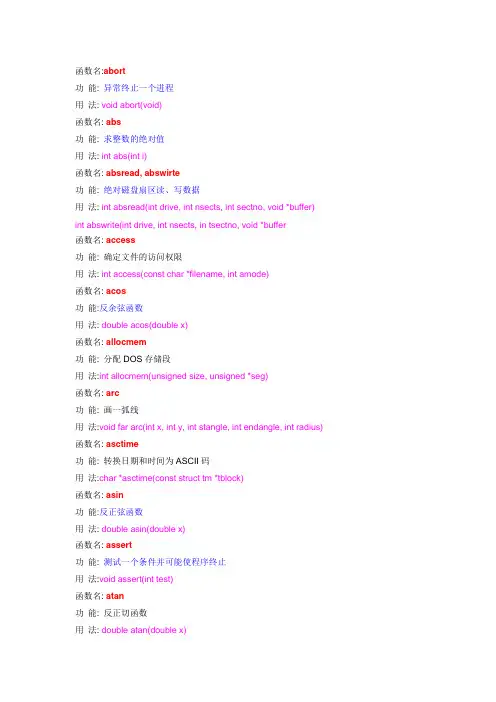
功能: 异常终止一个进程用法: void abort(void)函数名: abs功能: 求整数的绝对值用法: int abs(int i)函数名: absread, abswirte功能: 绝对磁盘扇区读、写数据用法: int absread(int drive, int nsects, int sectno, void *buffer) int abswrite(int drive, int nsects, in tsectno, void *buffer函数名: access功能: 确定文件的访问权限用法: int access(const char *filename, int amode)函数名: acos功能:反余弦函数用法: double acos(double x)函数名: allocmem功能: 分配DOS存储段用法:int allocmem(unsigned size, unsigned *seg)函数名: arc功能: 画一弧线用法:void far arc(int x, int y, int stangle, int endangle, int radius)函数名: asctime功能: 转换日期和时间为ASCII码用法:char *asctime(const struct tm *tblock)函数名: asin功能:反正弦函数用法: double asin(double x)函数名: assert功能: 测试一个条件并可能使程序终止用法:void assert(int test)函数名: atan功能: 反正切函数用法: double atan(double x)功能: 计算Y/X的反正切值用法: double atan2(double y, double x)函数名:atexit功能: 注册终止函数用法: int atexit(atexit_t func)函数名: atof功能: 把字符串转换成浮点数用法:double atof(const char *nptr)函数名: atoi功能: 把字符串转换成长整型数用法: int atoi(const char *nptr)函数名: atol功能: 把字符串转换成长整型数用法: long atol(const char *nptr)函数名: bar功能: 画一个二维条形图用法: void far bar(int left, int top, int right, int bottom)函数名: bar3d功能: 画一个三维条形图用法:void far bar3d(int left, int top, int right, int bottom,int depth, int topflag)函数名: bdos功能: DOS系统调用用法: int bdos(int dosfun, unsigned dosdx, unsigned dosal)函数名:bdosptr功能:DOS系统调用用法: int bdosptr(int dosfun, void *argument, unsigned dosal)函数名:bioscom功能: 串行I/O通信用法:int bioscom(int cmd, char abyte, int port)函数名:biosdisk功能: 软硬盘I/O用法:int biosdisk(int cmd, int drive, int head, int track, int sectorint nsects, void *buffer)函数名:biosequip功能: 检查设备用法:int biosequip(void)函数名:bioskey功能: 直接使用BIOS服务的键盘接口用法:int bioskey(int cmd)函数名:biosmemory功能: 返回存储块大小用法:int biosmemory(void)函数名:biosprint功能: 直接使用BIOS服务的打印机I/O用法:int biosprint(int cmd, int byte, int port)函数名:biostime功能: 读取或设置BIOS时间用法: long biostime(int cmd, long newtime)函数名: brk功能: 改变数据段空间分配用法:int brk(void *endds)函数名:bsearch功能: 二分法搜索用法:void *bsearch(const void *key, const void *base, size_t *nelem, size_t width, int(*fcmp)(const void *, const *))函数名: cabs功能: 计算复数的绝对值用法: double cabs(struct complex z);函数名:calloc功能:分配主存储器用法:void *calloc(size_t nelem, size_t elsize);函数名: ceil功能: 向上舍入用法: double ceil(double x);函数名: cgets功能: 从控制台读字符串用法: char *cgets(char *str)函数名:chdir功能: 改变工作目录用法: int chdir(const char *path);函数名:_chmod, chmod功能: 改变文件的访问方式用法: int chmod(const char *filename, int permiss);函数名:chsize功能: 改变文件大小用法: int chsize(int handle, long size);函数名: circle功能: 在给定半径以(x, y)为圆心画圆用法: void far circle(int x, int y, int radius);函数名: cleardevice功能: 清除图形屏幕用法: void far cleardevice(void);函数名:clearerr功能: 复位错误标志用法:void clearerr(FILE *stream);函数名: clearviewport功能: 清除图形视区用法: void far clearviewport(void);函数名:_close, close功能: 关闭文件句柄用法:int close(int handle);函数名: clock功能:确定处理器时间用法: clock_t clock(void);函数名:closegraph功能: 关闭图形系统用法: void far closegraph(void);函数名:clreol功能: 在文本窗口中清除字符到行末用法:void clreol(void)函数名:clrscr功能: 清除文本模式窗口用法:void clrscr(void);函数名: coreleft功能: 返回未使用内存的大小用法:unsigned coreleft(void);函数名: cos功能: 余弦函数用法:double cos(double x);函数名:cosh功能: 双曲余弦函数用法: dluble cosh(double x);函数名: country功能: 返回与国家有关的信息用法: struct COUNTRY *country(int countrycode, struct country *country); 函数名: cprintf功能: 送格式化输出至屏幕用法:int cprintf(const char *format[, argument, ...]);函数名: cputs功能: 写字符到屏幕用法: void cputs(const char *string);函数名: _creat creat功能: 创建一个新文件或重写一个已存在的文件用法: int creat (const char *filename, int permiss)函数名:creatnew功能: 创建一个新文件用法:int creatnew(const char *filename, int attrib);函数名: cscanf功能: 从控制台执行格式化输入用法:int cscanf(char *format[,argument, ...]);函数名: ctime功能: 把日期和时间转换为字符串用法:char *ctime(const time_t *time);功能: 设置Ctrl-Break处理程序用法: void ctrlbrk(*fptr)(void);函数名: delay功能: 将程序的执行暂停一段时间(毫秒)用法: void delay(unsigned milliseconds);函数名: delline功能: 在文本窗口中删去一行用法: void delline(void);函数名:detectgraph功能: 通过检测硬件确定图形驱动程序和模式用法: void far detectgraph(int far *graphdriver, int far *graphmode); 函数名: difftime功能: 计算两个时刻之间的时间差用法: double difftime(time_t time2, time_t time1);函数名: disable功能: 屏蔽中断用法:void disable(void);函数名: div功能: 将两个整数相除, 返回商和余数用法:div_t (int number, int denom);函数名: dosexterr功能: 获取扩展DOS错误信息用法:int dosexterr(struct DOSERR *dblkp);函数名: dostounix功能: 转换日期和时间为UNIX时间格式用法: long dostounix(struct date *dateptr, struct time *timeptr);函数名: drawpoly功能: 画多边形用法: void far drawpoly(int numpoints, int far *polypoints);函数名:dup功能: 复制一个文件句柄用法: int dup(int handle);函数名:dup2功能: 复制文件句柄用法: int dup2(int oldhandle, int newhandle);功能: 把一个浮点数转换为字符串用法: char ecvt(double value, int ndigit, int *decpt, int *sign);函数名: ellipse功能: 画一椭圆用法:void far ellipse(int x, int y, int stangle, int endangle,int xradius, int yradius);函数名: enable功能: 开放硬件中断用法: void enable(void);函数名: eof功能: 检测文件结束用法: int eof(int *handle);函数名: exec...功能: 装入并运行其它程序的函数用法: int execl(char *pathname, char *arg0, arg1, ..., argn, NULL); int execle(char *pathname, char *arg0, arg1, ..., argn, NULL,char *envp[]);int execlp(char *pathname, char *arg0, arg1, .., NULL);int execple(char *pathname, char *arg0, arg1, ..., NULL,char *envp[]);int execv(char *pathname, char *argv[]);int execve(char *pathname, char *argv[], char *envp[]);int execvp(char *pathname, char *argv[]);int execvpe(char *pathname, char *argv[], char *envp[]);函数名:exit功能: 终止程序用法: void exit(int status);函数名: exp功能: 指数函数用法: double exp(double x);函数名: gcvt功能: 把浮点数转换成字符串用法: char *gcvt(double value, int ndigit, char *buf);函数名: geninterrupt功能: 产生一个软中断函数名: getarccoords功能: 取得最后一次调用arc的坐标用法: void far getarccoords(struct arccoordstype far *arccoords); 函数名: getaspectratio功能: 返回当前图形模式的纵横比用法: void far getaspectratio(int far *xasp, int far *yasp);函数名: getbkcolor功能: 返回当前背景颜色用法: int far getbkcolor(void);函数名: getc功能: 从流中取字符用法: int getc(FILE *stream);函数名: getcbrk功能: 获取Control_break设置用法: int getcbrk(void);函数名: getch功能: 从控制台无回显地取一个字符用法: int getch(void);函数名: getchar功能: 从stdin流中读字符用法: int getchar(void);函数名: getche功能: 从控制台取字符(带回显)用法: int getche(void);函数名: getcolor功能: 返回当前画线颜色用法: int far getcolor(void);函数名: getcurdir功能: 取指定驱动器的当前目录用法: int getcurdir(int drive, char *direc);函数名: getcwd功能: 取当前工作目录用法: char *getcwd(char *buf, int n);函数名: getdate功能: 取DOS日期函数名: getdefaultpalette功能: 返回调色板定义结构用法: struct palettetype *far getdefaultpalette(void);函数名: getdisk功能: 取当前磁盘驱动器号用法: int getdisk(void);函数名: getdrivername功能: 返回指向包含当前图形驱动程序名字的字符串指针用法: char *getdrivename(void);函数名: getdta功能: 取磁盘传输地址用法: char far *getdta(void);函数名: getenv功能: 从环境中取字符串用法: char *getenv(char *envvar);函数名: getfat, getfatd功能: 取文件分配表信息用法: void getfat(int drive, struct fatinfo *fatblkp);函数名: getfillpattern功能: 将用户定义的填充模式拷贝到内存中用法: void far getfillpattern(char far *upattern);函数名: getfillsettings功能: 取得有关当前填充模式和填充颜色的信息用法: void far getfillsettings(struct fillsettingstype far *fillinfo); 函数名: getftime功能: 取文件日期和时间用法: int getftime(int handle, struct ftime *ftimep);函数名: getgraphmode功能: 返回当前图形模式用法: int far getgraphmode(void);函数名: getftime功能: 取文件日期和时间用法: int getftime(int handle, struct ftime *ftimep);函数名: getgraphmode功能: 返回当前图形模式用法: int far getgraphmode(void);函数名: getimage功能: 将指定区域的一个位图存到主存中用法: void far getimage(int left, int top, int right, int bottom,void far *bitmap);函数名: getlinesettings功能: 取当前线型、模式和宽度用法: void far getlinesettings(struct linesettingstype far *lininfo): 函数名: getmaxx功能: 返回屏幕的最大x坐标用法: int far getmaxx(void);函数名: getmaxy功能: 返回屏幕的最大y坐标用法: int far getmaxy(void);函数名: getmodename功能: 返回含有指定图形模式名的字符串指针用法: char *far getmodename(int mode_name);函数名: getmoderange功能: 取给定图形驱动程序的模式范围用法: void far getmoderange(int graphdriver, int far *lomode,int far *himode);函数名: getpalette功能: 返回有关当前调色板的信息用法: void far getpalette(struct palettetype far *palette);函数名: getpass功能: 读一个口令用法: char *getpass(char *prompt);函数名: getpixel功能: 取得指定像素的颜色用法: int far getpixel(int x, int y);函数名: gets功能: 从流中取一字符串用法: char *gets(char *string);函数名: gettext功能: 将文本方式屏幕上的文本拷贝到存储区用法: int gettext(int left, int top, int right, int bottom, void *destin);函数名: gettextinfo功能: 取得文本模式的显示信息用法: void gettextinfo(struct text_info *inforec);函数名: gettextsettings功能: 返回有关当前图形文本字体的信息用法: void far gettextsettings(struct textsettingstype far *textinfo); 函数名: gettime功能: 取得系统时间用法: void gettime(struct time *timep);函数名: getvect功能: 取得中断向量入口用法: void interrupt(*getvect(int intr_num));函数名: getverify功能: 返回DOS校验标志状态用法: int getverify(void);函数名: getviewsetting功能: 返回有关当前视区的信息用法: void far getviewsettings(struct viewporttype far *viewport); 函数名: getw功能: 从流中取一整数用法: int getw(FILE *strem);函数名: getx功能: 返回当前图形位置的x坐标用法: int far getx(void);函数名: gety功能: 返回当前图形位置的y坐标用法: int far gety(void);函数名: gmtime功能: 把日期和时间转换为格林尼治标准时间(GMT)用法: struct tm *gmtime(long *clock);函数名: gotoxy功能: 在文本窗口中设置光标用法: void gotoxy(int x, int y);函数名: gotoxy功能: 在文本窗口中设置光标用法: void gotoxy(int x, int y);函数名: graphdefaults功能: 将所有图形设置复位为它们的缺省值用法: void far graphdefaults(void);函数名: grapherrormsg功能: 返回一个错误信息串的指针用法: char *far grapherrormsg(int errorcode);函数名: graphresult功能: 返回最后一次不成功的图形操作的错误代码用法: int far graphresult(void);函数名: _graphfreemem功能: 用户可修改的图形存储区释放函数用法: void far _graphfreemem(void far *ptr, unsigned size);函数名: _graphgetmem功能: 用户可修改的图形存储区分配函数用法: void far *far _graphgetmem(unsigned size);函数名: harderr功能: 建立一个硬件错误处理程序用法: void harderr(int (*fptr)());函数名: hardresume功能: 硬件错误处理函数用法: void hardresume(int rescode);函数名: highvideo功能: 选择高亮度文本字符用法: void highvideo(void);函数名: hypot功能: 计算直角三角形的斜边长用法: double hypot(double x, double y);函数名: imagesize功能: 返回保存位图像所需的字节数用法: unsigned far imagesize(int left, int top, int right, int bottom); 函数名: initgraph功能: 初始化图形系统用法: void far initgraph(int far *graphdriver, int far *graphmode函数名: inport功能: 从硬件端口中输入用法: int inp(int protid);函数名: insline功能: 在文本窗口中插入一个空行用法: void insline(void);函数名: installuserdriver功能: 安装设备驱动程序到BGI设备驱动程序表中用法: int far installuserdriver(char far *name, int (*detect)(void));函数名: installuserfont功能: 安装未嵌入BGI系统的字体文件(CHR)用法: int far installuserfont(char far *name);函数名: int86功能: 通用8086软中断接口用法: int int86(int intr_num, union REGS *inregs, union REGS *outregs) 函数名: int86x功能: 通用8086软中断接口用法: int int86x(int intr_num, union REGS *insegs, union REGS *outregs, 函数名: intdos功能: 通用DOS接口用法: int intdos(union REGS *inregs, union REGS *outregs);函数名: intdosx功能: 通用DOS中断接口用法: int intdosx(union REGS *inregs, union REGS *outregs,struct SREGS *segregs);函数名: intr功能: 改变软中断接口用法: void intr(int intr_num, struct REGPACK *preg);函数名: ioctl功能: 控制I/O设备用法: int ioctl(int handle, int cmd[,int *argdx, int argcx]);函数名: isatty功能: 检查设备类型用法: int isatty(int handle);函数名: itoa功能: 把一整数转换为字符串用法: char *itoa(int value, char *string, int radix);函数名: kbhit功能: 检查当前按下的键用法: int kbhit(void);函数名: keep功能: 退出并继续驻留用法: void keep(int status, int size);函数名: kbhit功能: 检查当前按下的键用法: int kbhit(void);函数名: keep功能: 退出并继续驻留用法: void keep(int status, int size);函数名: labs用法: long labs(long n);函数名: ldexp功能: 计算value*2的幂用法: double ldexp(double value, int exp);函数名: ldiv功能: 两个长整型数相除, 返回商和余数用法: ldiv_t ldiv(long lnumer, long ldenom);函数名: lfind功能: 执行线性搜索用法: void *lfind(void *key, void *base, int *nelem, int width,int (*fcmp)());函数名: line功能: 在指定两点间画一直线用法: void far line(int x0, int y0, int x1, int y1);函数名: linerel功能: 从当前位置点(CP)到与CP有一给定相对距离的点画一直线用法: void far linerel(int dx, int dy);函数名: localtime功能: 把日期和时间转变为结构用法: struct tm *localtime(long *clock);函数名: lock功能: 设置文件共享锁用法: int lock(int handle, long offset, long length);函数名: log功能: 对数函数ln(x)用法: double log(double x);函数名: log10功能: 对数函数log用法: double log10(double x);函数名: longjump功能: 执行非局部转移用法: void longjump(jmp_buf env, int val);函数名: lowvideo功能: 选择低亮度字符用法: void lowvideo(void);函数名: lrotl, _lrotl功能: 将无符号长整型数向左循环移位用法: unsigned long lrotl(unsigned long lvalue, int count);unsigned long _lrotl(unsigned long lvalue, int count);函数名: lsearch功能: 线性搜索用法: void *lsearch(const void *key, void *base, size_t *nelem,size_t width, int (*fcmp)(const void *, const void *));函数名: lseek功能: 移动文件读/写指针用法: long lseek(int handle, long offset, int fromwhere);main()主函数每一C 程序都必须有一main() 函数, 可以根据自己的爱好把它放在程序的某个地方。
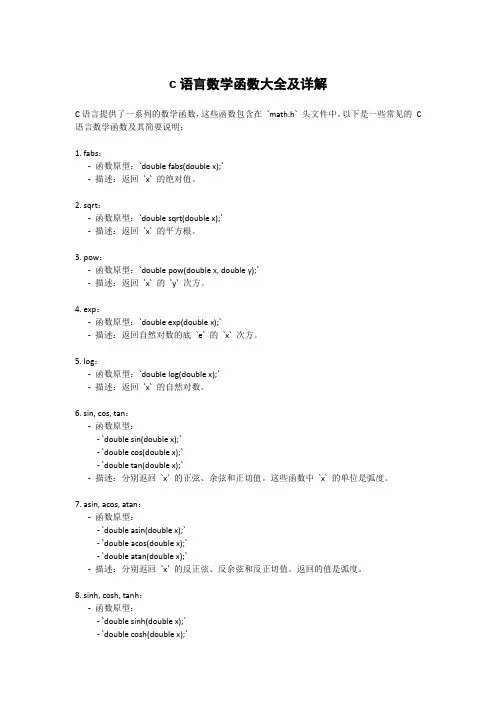
c语言数学函数大全及详解C语言提供了一系列的数学函数,这些函数包含在`math.h` 头文件中。
以下是一些常见的C 语言数学函数及其简要说明:1. fabs:-函数原型:`double fabs(double x);`-描述:返回`x` 的绝对值。
2. sqrt:-函数原型:`double sqrt(double x);`-描述:返回`x` 的平方根。
3. pow:-函数原型:`double pow(double x, double y);`-描述:返回`x` 的`y` 次方。
4. exp:-函数原型:`double exp(double x);`-描述:返回自然对数的底`e` 的`x` 次方。
5. log:-函数原型:`double log(double x);`-描述:返回`x` 的自然对数。
6. sin, cos, tan:-函数原型:- `double sin(double x);`- `double cos(double x);`- `double tan(double x);`-描述:分别返回`x` 的正弦、余弦和正切值。
这些函数中`x` 的单位是弧度。
7. asin, acos, atan:-函数原型:- `double asin(double x);`- `double acos(double x);`- `double atan(double x);`-描述:分别返回`x` 的反正弦、反余弦和反正切值。
返回的值是弧度。
8. sinh, cosh, tanh:-函数原型:- `double sinh(double x);`- `double cosh(double x);`- `double tanh(double x);`-描述:分别返回`x` 的双曲正弦、双曲余弦和双曲正切值。
9. ceil:-函数原型:`double ceil(double x);`-描述:返回不小于`x` 的最小整数值。
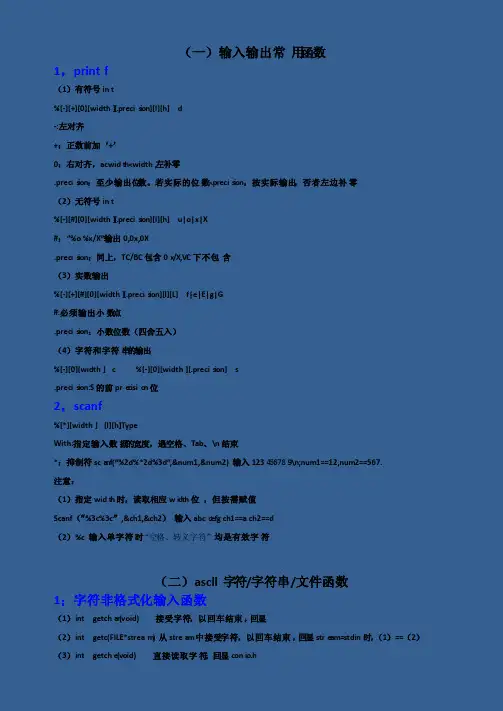
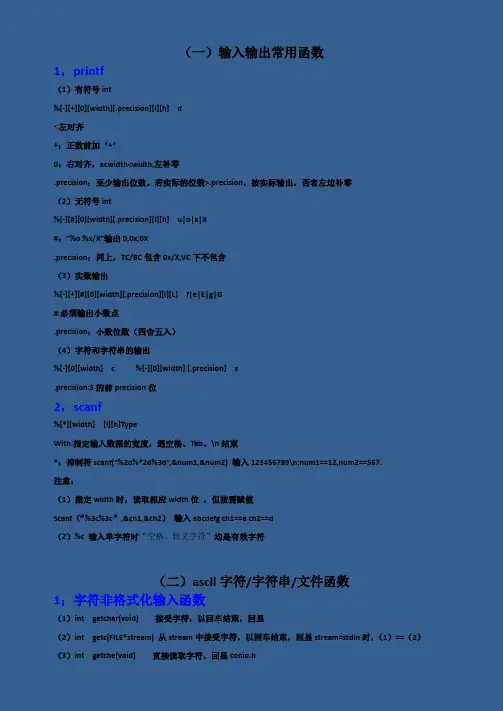
(一)输入输出常用函数1,printf(1)有符号int%[-][+][0][width][.precision][l][h] d-:左对齐+:正数前加‘+’0:右对齐,acwidth<width,左补零.precision:至少输出位数。
若实际的位数>.precision,按实际输出,否者左边补零(2)无符号int%[-][#][0][width][.precision][l][h] u|o|x|X#:”%o %x/X”输出0,0x,0X.precision:同上,TC/BC包含0x/X,VC下不包含(3)实数输出%[-][+][#][0][width][.precision][l][L] f|e|E|g|G#:必须输出小数点.precision:小数位数(四舍五入)(4)字符和字符串的输出%[-][0][width] c %[-][0][width] [.precision] s.precision:S的前precision位2,scanf%[*][width] [l][h]TypeWith:指定输入数据的宽度,遇空格、Tab、\n结束*:抑制符scanf(“%2d%*2d%3d”,&num1,&num2) 输入123456789\n;num1==12,num2==567.注意:(1)指定width时,读取相应width位,但按需赋值Scanf(“%3c%3c”,&ch1,&ch2)输入a bc d efg ch1==a ch2==d(2)%c 输入单字符时“空格、转义字符”均是有效字符(二)ascll字符/字符串/文件函数1;字符非格式化输入函数(1)int getchar(void) 接受字符,以回车结束,回显(2)int getc(FILE*stream) 从stream中接受字符,以回车结束,回显stream=stdin时,(1)==(2)(3)int getche(void) 直接读取字符,回显conio.h(4)int getchar(void) 直接读取字符,不回显conio.h注意:(1,2)对于回车键返回‘\n’(3,4)对于回车键返回‘\r’2;字符/串非格式化输出函数(1)int putchar(int c) 正常返回字符代码值,出错返回EOF(2)int putc(int c,FILE*stream) 正常返回字符代码值,出错返回EOF stream==stdout(1)=(2)(3)int puts(char*stream) 自动回车换行1;字符串的赋值#include< string.h memory.h >Void *memset (void *s, char ch, unsigned n)将以S为首地址的,一片连续的N个字节内存单元赋值为CH.Void *memcpy ( void *d, void*s, unsigned n)将以S为首地址的一片连续的N个字节内存单元的值拷贝到以D为首地址的一片连续的内存单元中。
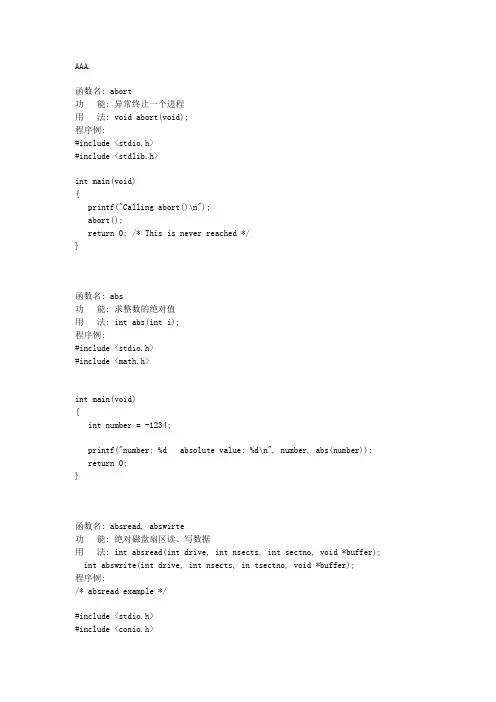
AAA.函数名: abort功能: 异常终止一个进程用法: void abort(void);程序例:#include <stdio.h>#include <stdlib.h>int main(void){printf("Calling abort()\n");abort();return 0; /* This is never reached */}函数名: abs功能: 求整数的绝对值用法: int abs(int i);程序例:#include <stdio.h>#include <math.h>int main(void){int number = -1234;printf("number: %d absolute value: %d\n", number, abs(number)); return 0;}函数名: absread, abswirte功能: 绝对磁盘扇区读、写数据用法: int absread(int drive, int nsects, int sectno, void *buffer); int abswrite(int drive, int nsects, in tsectno, void *buffer);程序例:/* absread example */#include <stdio.h>#include <conio.h>#include <process.h>#include <dos.h>int main(void){int i, strt, ch_out, sector;char buf[512];printf("Insert a diskette into drive A and press any key\n"); getch();sector = 0;if (absread(0, 1, sector, &buf) != 0){perror("Disk problem");exit(1);}printf("Read OK\n");strt = 3;for (i=0; i<80; i++){ch_out = buf[strt+i];putchar(ch_out);}printf("\n");return(0);}函数名: access功能: 确定文件的访问权限用法: int access(const char *, int amode);程序例:#include <stdio.h>#include <io.h>int (char *);int main(void){printf("Does NOTEXIST.FIL exist: %s\n",("NOTEXISTS.FIL") ? "YES" : "NO");return 0;}int (char *){return (access(, 0) == 0);}函数名: acos功能: 反余弦函数用法: double acos(double x);程序例:#include <stdio.h>#include <math.h>int main(void){double result;double x = 0.5;result = acos(x);printf("The arc cosine of %lf is %lf\n", x, result);return 0;}函数名: allocmem功能: 分配DOS存储段用法: int allocmem(unsigned size, unsigned *seg);程序例:#include <dos.h>#include <alloc.h>#include <stdio.h>int main(void){unsigned int size, segp;int stat;size = 64; /* (64 x 16) = 1024 bytes */stat = allocmem(size, &segp);if (stat == -1)printf("Allocated memory at segment: %x\n", segp);elseprintf("Failed: maximum number of paragraphs available is %u\n",stat);return 0;}函数名: arc功能: 画一弧线用法: void far arc(int x, int y, int stangle, int endangle, int radius); 程序例:#include <graphics.h>#include <stdlib.h>#include <stdio.h>#include <conio.h>int main(void){/* request auto detection */int gdriver = DETECT, gmode, errorcode;int midx, midy;int stangle = 45, endangle = 135;int radius = 100;/* initialize graphics and local variables */initgraph(&gdriver, &gmode, "");/* read result of initialization */errorcode = graphresult(); /* an error occurred */if (errorcode != grOk){printf("Graphics error: %s\n", grapherrormsg(errorcode));printf("Press any key to halt:");getch();exit(1); /* terminate with an error code */}midx = getmaxx() / 2;midy = getmaxy() / 2;setcolor(getmaxcolor());/* draw arc */arc(midx, midy, stangle, endangle, radius);/* clean up */getch();closegraph();return 0;}函数名: asctime功能: 转换日期和时间为ASCII码用法: char *asctime(const struct tm *tblock);程序例:#include <stdio.h>#include <string.h>#include <time.h>int main(void){struct tm t;char str[80];/* sample loading of tm structure */t.tm_sec = 1; /* Seconds */t.tm_min = 30; /* Minutes */t.tm_hour = 9; /* Hour */t.tm_mday = 22; /* Day of the Month */t.tm_mon = 11; /* Month */t.tm_year = 56; /* Year - does not include century */t.tm_wday = 4; /* Day of the week */t.tm_yday = 0; /* Does not show in asctime */t.tm_isdst = 0; /* Is Daylight SavTime; does not show in asctime *//* converts structure to null terminatedstring */strcpy(str, asctime(&t));printf("%s\n", str);return 0;}函数名: asin功能: 反正弦函数用法: double asin(double x);程序例:#include <stdio.h>#include <math.h>int main(void){double result;double x = 0.5;result = asin(x);printf("The arc sin of %lf is %lf\n", x, result);return(0);}函数名: assert功能: 测试一个条件并可能使程序终止用法: void assert(int test);程序例:#include <assert.h>#include <stdio.h>#include <stdlib.h>struct ITEM {int key;int value;};/* add item to list, make sure list is not null */ void additem(struct ITEM *itemptr) {assert(itemptr != NULL);/* add item to list */}int main(void){additem(NULL);return 0;}函数名: atan功能: 反正切函数用法: double atan(double x);程序例:#include <stdio.h>#include <math.h>int main(void){double result;double x = 0.5;result = atan(x);printf("The arc tangent of %lf is %lf\n", x, result);return(0);}函数名: atan2功能: 计算Y/X的反正切值用法: double atan2(double y, double x);程序例:#include <stdio.h>#include <math.h>int main(void){double result;double x = 90.0, y = 45.0;result = atan2(y, x);printf("The arc tangent ratio of %lf is %lf\n", (y / x), result);return 0;}函数名: atexit功能: 注册终止函数用法: int atexit(atexit_t func);程序例:#include <stdio.h>#include <stdlib.h>void exit_fn1(void){printf("Exit function #1 called\n");}void exit_fn2(void){printf("Exit function #2 called\n");}int main(void){/* post exit function #1 */atexit(exit_fn1);/* post exit function #2 */atexit(exit_fn2);return 0;}函数名: atof功能: 把字符串转换成浮点数用法: double atof(const char *nptr);程序例:#include <stdlib.h>#include <stdio.h>int main(void){float f;char *str = "12345.67";f = atof(str);printf("string = %s float = %f\n", str, f);return 0;}函数名: atoi功能: 把字符串转换成长整型数用法: int atoi(const char *nptr);程序例:#include <stdlib.h>#include <stdio.h>int main(void){int n;char *str = "12345.67";n = atoi(str);printf("string = %s integer = %d\n", str, n);return 0;}函数名: atol功能: 把字符串转换成长整型数用法: long atol(const char *nptr);程序例:#include <stdlib.h>#include <stdio.h>int main(void){long l;char *str = "98765432";l = atol(lstr);printf("string = %s integer = %ld\n", str, l);return(0);}BBB.函数名: bar功能: 画一个二维条形图用法: void far bar(int left, int top, int right, int bottom);程序例:#include <graphics.h>#include <stdlib.h>#include <stdio.h>#include <conio.h>int main(void){/* request auto detection */int gdriver = DETECT, gmode, errorcode;int midx, midy, i;/* initialize graphics and local variables */initgraph(&gdriver, &gmode, "");/* read result of initialization */errorcode = graphresult();if (errorcode != grOk) /* an error occurred */{printf("Graphics error: %s\n", grapherrormsg(errorcode));printf("Press any key to halt:");getch();exit(1); /* terminate with an error code */}midx = getmaxx() / 2;midy = getmaxy() / 2;/* loop through the fill patterns */for (i=SOLID_FILL; i<USER_FILL; i++){/* set the fill style */setfillstyle(i, getmaxcolor());/* draw the bar */bar(midx-50, midy-50, midx+50,midy+50);getch();}/* clean up */closegraph();return 0;}函数名: bar3d功能: 画一个三维条形图用法: void far bar3d(int left, int top, int right, int bottom,int depth, int topflag); 程序例:#include <graphics.h>#include <stdlib.h>#include <stdio.h>#include <conio.h>int main(void){/* request auto detection */int gdriver = DETECT, gmode, errorcode;int midx, midy, i;/* initialize graphics, local variables */initgraph(&gdriver, &gmode, "");/* read result of initialization */errorcode = graphresult();if (errorcode != grOk) /* an error occurred */{printf("Graphics error: %s\n", grapherrormsg(errorcode));printf("Press any key to halt:");getch();exit(1); /* terminate with error code */}midx = getmaxx() / 2;midy = getmaxy() / 2;/* loop through the fill patterns */for (i=EMPTY_FILL; i<USER_FILL; i++){/* set the fill style */setfillstyle(i, getmaxcolor());/* draw the 3-d bar */bar3d(midx-50, midy-50, midx+50, midy+50, 10, 1);getch();}/* clean up */closegraph();return 0;}函数名: bdos功能: DOS系统调用用法: int bdos(int dosfun, unsigned dosdx, unsigned dosal); 程序例:#include <stdio.h>#include <dos.h>/* Get current drive as 'A', 'B', ... */char current_drive(void){char curdrive;/* Get current disk as 0, 1, ... */curdrive = bdos(0x19, 0, 0);return('A' + curdrive);}int main(void){printf("The current drive is %c:\n", current_drive());return 0;}函数名: bdosptr功能: DOS系统调用用法: int bdosptr(int dosfun, void *argument, unsigned dosal); 程序例:#include <string.h>#include <stdio.h>#include <dir.h>#include <dos.h>#include <errno.h>#include <stdlib.h>#define BUFLEN 80int main(void){char buffer[BUFLEN];int test;printf("Enter full pathname of a directory\n");gets(buffer);test = bdosptr(0x3B,buffer,0);if(test){printf("DOS error message: %d\n", errno);/* See errno.h for error listings */exit (1);}getcwd(buffer, BUFLEN);printf("The current directory is: %s\n", buffer);return 0;}函数名: bioscom功能: 串行I/O通信用法: int bioscom(int cmd, char abyte, int port);程序例:#include <bios.h>#include <conio.h>#define COM1 0#define DATA_READY 0x100#define TRUE 1#define FALSE 0#define SETTINGS ( 0x80 | 0x02 | 0x00 | 0x00)int main(void){int in, out, status, DONE = FALSE;bioscom(0, SETTINGS, COM1);cprintf("... BIOSCOM [ESC] to exit ...\n");while (!DONE){status = bioscom(3, 0, COM1);if (status & DATA_READY)if ((out = bioscom(2, 0, COM1) & 0x7F) != 0)putch(out);if (kbhit()){if ((in = getch()) == '\x1B')DONE = TRUE;bioscom(1, in, COM1);}}return 0;}函数名: biosdisk功能: 软硬盘I/O用法: int biosdisk(int cmd, int drive, int head, int track, int sector int nsects, void *buffer);程序例:#include <bios.h>#include <stdio.h>int main(void){int result;char buffer[512];printf("Testing to see if drive a: is ready\n");result = biosdisk(4,0,0,0,0,1,buffer);result &= 0x02;(result) ? (printf("Drive A: Ready\n")) :(printf("Drive A: Not Ready\n"));return 0;}函数名: biosequip功能: 检查设备用法: int biosequip(void);程序例:#include <bios.h>#include <stdio.h>int main(void){int result;char buffer[512];printf("Testing to see if drive a: is ready\n");result = biosdisk(4,0,0,0,0,1,buffer);result &= 0x02;(result) ? (printf("Drive A: Ready\n")) :(printf("Drive A: Not Ready\n"));return 0;}函数名: bioskey功能: 直接使用BIOS服务的键盘接口用法: int bioskey(int cmd);程序例:#include <stdio.h>#include <bios.h>#include <ctype.h>#define RIGHT 0x01#define LEFT 0x02#define CTRL 0x04#define ALT 0x08int main(void){int key, modifiers;/* function 1 returns 0 until a key is pressed */while (bioskey(1) == 0);/* function 0 returns the key that is waiting */key = bioskey(0);/* use function 2 to determine if shift keys were used */ modifiers = bioskey(2);if (modifiers){printf("[");if (modifiers & RIGHT) printf("RIGHT");if (modifiers & LEFT) printf("LEFT");if (modifiers & CTRL) printf("CTRL");if (modifiers & ALT) printf("ALT");printf("]");}/* print out the character read */if (isalnum(key & 0xFF))printf("'%c'\n", key);elseprintf("%#02x\n", key);return 0;函数名: biosmemory功能: 返回存储块大小用法:int biosmemory(void);程序例:#include <stdio.h>#include <bios.h>int main(void){int memory_size;memory_size = biosmemory(); /* returns value up to 640K */printf("RAM size = %dK\n",memory_size);return 0;}函数名: biosprint功能: 直接使用BIOS服务的打印机I/O用法: int biosprint(int cmd, int byte, int port);程序例:#include <stdio.h>#include <conio.h>#include <bios.h>int main(void){#define STATUS 2 /* printer status command */#define PORTNUM 0 /* port number for LPT1 */int status, abyte=0;printf("Please turn off your printer. Press any key to continue\n");getch();status = biosprint(STATUS, abyte, PORTNUM);if (status & 0x01)printf("Device time out.\n");if (status & 0x08)printf("I/O error.\n");if (status & 0x10)printf("Selected.\n");if (status & 0x20)printf("Out of paper.\n");if (status & 0x40)printf("Acknowledge.\n");if (status & 0x80)printf("Not busy.\n");return 0;}函数名: biostime功能: 读取或设置BIOS时间用法: long biostime(int cmd, long newtime);程序例:#include <stdio.h>#include <bios.h>#include <time.h>#include <conio.h>int main(void){long bios_time;clrscr();cprintf("The number of clock ticks since midnight is:\r\n");cprintf("The number of seconds since midnight is:\r\n");cprintf("The number of minutes since midnight is:\r\n");cprintf("The number of hours since midnight is:\r\n");cprintf("\r\nPress any key to quit:");while(!kbhit()){bios_time = biostime(0, 0L);gotoxy(50, 1);cprintf("%lu", bios_time);gotoxy(50, 2);cprintf("%.4f", bios_time / CLK_TCK);gotoxy(50, 3);cprintf("%.4f", bios_time / CLK_TCK / 60);gotoxy(50, 4);cprintf("%.4f", bios_time / CLK_TCK / 3600);}return 0;}函数名: brk功能: 改变数据段空间分配用法: int brk(void *endds);程序例:#include <stdio.h>#include <alloc.h>int main(void){char *ptr;printf("Changing allocation with brk()\n");ptr = malloc(1);printf("Before brk() call: %lu bytes free\n", coreleft());brk(ptr+1000);printf(" After brk() call: %lu bytes free\n", coreleft());return 0;}函数名: bsearch功能: 二分法搜索用法: void *bsearch(const void *key, const void *base, size_t *nelem, size_t width, int(*fcmp)(const void *, const *));程序例:#include <stdlib.h>#include <stdio.h>#define NELEMS(arr) (sizeof(arr) / sizeof(arr[0]))int numarray[] = {123, 145, 512, 627, 800, 933};int numeric (const int *p1, const int *p2){return(*p1 - *p2);}int lookup(int key){int *itemptr;/* The cast of (int(*)(const void *,const void*))is needed to avoid a type mismatch error atcompile time */itemptr = bsearch (&key, numarray, NELEMS(numarray),sizeof(int), (int(*)(const void *,const void *))numeric);return (itemptr != NULL);}int main(void){if (lookup(512))printf("512 is in the table.\n");elseprintf("512 isn't in the table.\n");return 0;}CCC.函数名: cabs功能: 计算复数的绝对值用法: double cabs(struct complex z);程序例:#include <stdio.h>#include <math.h>int main(void){struct complex z;double val;z.x = 2.0;z.y = 1.0;val = cabs(z);printf("The absolute value of %.2lfi %.2lfj is %.2lf", z.x, z.y, val);return 0;}函数名: calloc功能: 分配主存储器用法: void *calloc(size_t nelem, size_t elsize);程序例:#include <stdio.h>#include <alloc.h>int main(void){char *str = NULL;/* allocate memory for string */str = calloc(10, sizeof(char));/* copy "Hello" into string */strcpy(str, "Hello");/* display string */printf("String is %s\n", str);/* free memory */free(str);return 0;}函数名: ceil功能: 向上舍入用法: double ceil(double x);程序例:#include <math.h>#include <stdio.h>int main(void){double number = 123.54;double down, up;down = floor(number);up = ceil(number);printf("original number %5.2lf\n", number);printf("number rounded down %5.2lf\n", down);printf("number rounded up %5.2lf\n", up);return 0;}函数名: cgets功能: 从控制台读字符串用法: char *cgets(char *str);程序例:#include <stdio.h>#include <conio.h>int main(void){char buffer[83];char *p;/* There's space for 80 characters plus the NULL terminator */buffer[0] = 81;printf("Input some chars:");p = cgets(buffer);printf("\ncgets read %d characters: \"%s\"\n", buffer[1], p);printf("The returned pointer is %p, buffer[0] is at %p\n", p, &buffer);/* Leave room for 5 characters plus the NULL terminator */buffer[0] = 6;printf("Input some chars:");p = cgets(buffer);printf("\ncgets read %d characters: \"%s\"\n", buffer[1], p);printf("The returned pointer is %p, buffer[0] is at %p\n", p, &buffer);return 0;}函数名: chdir功能: 改变工作目录用法: int chdir(const char *path);程序例:#include <stdio.h>#include <stdlib.h>#include <dir.h>char old_dir[MAXDIR];char new_dir[MAXDIR];int main(void){if (getcurdir(0, old_dir)){perror("getcurdir()");exit(1);}printf("Current directory is: \\%s\n", old_dir);if (chdir("\\")){perror("chdir()");exit(1);}if (getcurdir(0, new_dir)){perror("getcurdir()");exit(1);}printf("Current directory is now: \\%s\n", new_dir);printf("\nChanging back to orignal directory: \\%s\n", old_dir);if (chdir(old_dir)){perror("chdir()");exit(1);}return 0;}函数名: _chmod, chmod功能: 改变文件的访问方式用法: int chmod(const char *, int permiss);程序例:#include <sys\stat.h>#include <stdio.h>#include <io.h>void make_read_only(char *);int main(void){make_read_only("NOTEXIST.FIL");make_read_only("MY");return 0;}void make_read_only(char *){int stat;stat = chmod(, S_IREAD);if (stat)printf("Couldn't make %s read-only\n", );elseprintf("Made %s read-only\n", );}函数名: chsize功能: 改变文件大小用法: int chsize(int handle, long size);程序例:#include <string.h>#include <fcntl.h>#include <io.h>int main(void){int handle;char buf[11] = "0123456789";/* create text 10 bytes */handle = open("DUMMY.FIL", O_CREAT);write(handle, buf, strlen(buf));/* truncate the 5 bytes in size */chsize(handle, 5);/* close the file */close(handle);return 0;}函数名: circle功能: 在给定半径以(x, y)为圆心画圆用法: void far circle(int x, int y, int radius);程序例:#include <graphics.h>#include <stdlib.h>#include <stdio.h>#include <conio.h>int main(void){/* request auto detection */int gdriver = DETECT, gmode, errorcode;int midx, midy;int radius = 100;/* initialize graphics and local variables */initgraph(&gdriver, &gmode, "");/* read result of initialization */errorcode = graphresult();if (errorcode != grOk) /* an error occurred */{printf("Graphics error: %s\n", grapherrormsg(errorcode));printf("Press any key to halt:");getch();exit(1); /* terminate with an error code */}midx = getmaxx() / 2;midy = getmaxy() / 2;setcolor(getmaxcolor());/* draw the circle */circle(midx, midy, radius);/* clean up */getch();closegraph();return 0;}函数名: cleardevice功能: 清除图形屏幕用法: void far cleardevice(void);程序例:#include <graphics.h>#include <stdlib.h>#include <stdio.h>#include <conio.h>int main(void){/* request auto detection */int gdriver = DETECT, gmode, errorcode;int midx, midy;/* initialize graphics and local variables */initgraph(&gdriver, &gmode, "");/* read result of initialization */errorcode = graphresult();if (errorcode != grOk) /* an error occurred */{printf("Graphics error: %s\n", grapherrormsg(errorcode));printf("Press any key to halt:");getch();exit(1); /* terminate with an error code */}midx = getmaxx() / 2;midy = getmaxy() / 2;setcolor(getmaxcolor());/* for centering screen messages */settextjustify(CENTER_TEXT, CENTER_TEXT);/* output a message to the screen */outtextxy(midx, midy, "press any key to clear the screen:");/* wait for a key */getch();/* clear the screen */cleardevice();/* output another message */outtextxy(midx, midy, "press any key to quit:");/* clean up */getch();closegraph();return 0;}函数名: clearerr功能: 复位错误标志用法:void clearerr(FILE *stream);程序例:#include <stdio.h>int main(void){FILE *fp;char ch;/* open a writing */fp = fopen("DUMMY.FIL", "w");/* force an error condition by attempting to read */ ch = fgetc(fp);printf("%c\n",ch);if (ferror(fp)){/* display an error message */printf("Error reading from DUMMY.FIL\n");/* reset the error and EOF indicators */clearerr(fp);}fclose(fp);return 0;}函数名: clearviewport功能: 清除图形视区用法: void far clearviewport(void);程序例:#include <graphics.h>#include <stdlib.h>#include <stdio.h>#include <conio.h>#define CLIP_ON 1 /* activates clipping in viewport */int main(void){/* request auto detection */int gdriver = DETECT, gmode, errorcode;int ht;/* initialize graphics and local variables */initgraph(&gdriver, &gmode, "");/* read result of initialization */errorcode = graphresult();if (errorcode != grOk) /* an error occurred */{printf("Graphics error: %s\n", grapherrormsg(errorcode));printf("Press any key to halt:");getch();exit(1); /* terminate with an error code */}setcolor(getmaxcolor());ht = textheight("W");/* message in default full-screen viewport */outtextxy(0, 0, "* <-- (0, 0) in default viewport");/* create a smaller viewport */setviewport(50, 50, getmaxx()-50, getmaxy()-50, CLIP_ON);/* display some messages */outtextxy(0, 0, "* <-- (0, 0) in smaller viewport");outtextxy(0, 2*ht, "Press any key to clear viewport:");/* wait for a key */getch();/* clear the viewport */clearviewport();/* output another message */outtextxy(0, 0, "Press any key to quit:");/* clean up */getch();closegraph();return 0;}函数名: _close, close功能: 关闭文件句柄用法: int close(int handle);程序例:#include <string.h>#include <stdio.h>#include <fcntl.h>#include <io.h>main(){int handle;char buf[11] = "0123456789";/* create a 10 bytes */handle = open("NEW.FIL", O_CREAT);if (handle > -1){write(handle, buf, strlen(buf));/* close the file */close(handle);}else{printf("Error opening file\n");}return 0;}函数名: clock功能: 确定处理器时间用法: clock_t clock(void);程序例:#include <time.h>#include <stdio.h>#include <dos.h>int main(void){clock_t start, end;start = clock();delay(2000);end = clock();printf("The time was: %f\n", (end - start) / CLK_TCK);return 0;}函数名: closegraph功能: 关闭图形系统用法: void far closegraph(void);程序例:#include <graphics.h>#include <stdlib.h>#include <stdio.h>#include <conio.h>int main(void){/* request auto detection */int gdriver = DETECT, gmode, errorcode;int x, y;/* initialize graphics mode */initgraph(&gdriver, &gmode, "");/* read result of initialization */errorcode = graphresult();if (errorcode != grOk) /* an erroroccurred */{printf("Graphics error: %s\n", grapherrormsg(errorcode));printf("Press any key to halt:");getch();exit(1); /* terminate with an error code */}x = getmaxx() / 2;y = getmaxy() / 2;/* output a message */settextjustify(CENTER_TEXT, CENTER_TEXT);outtextxy(x, y, "Press a key to close the graphics system:");/* wait for a key */getch();/* closes down the graphics system */closegraph();printf("We're now back in text mode.\n");printf("Press any key to halt:");getch();return 0;}函数名: clreol功能: 在文本窗口中清除字符到行末用法: void clreol(void);程序例:#include <conio.h>int main(void){clrscr();cprintf("The function CLREOL clears all characters from the\r\n");cprintf("cursor position to the end of the line within the\r\n");cprintf("current text window, without moving the cursor.\r\n");cprintf("Press any key to continue . . .");gotoxy(14, 4);getch();clreol();getch();return 0;}函数名: clrscr功能: 清除文本模式窗口用法: void clrscr(void);程序例:#include <conio.h>int main(void){int i;clrscr();for (i = 0; i < 20; i++)cprintf("%d\r\n", i);cprintf("\r\nPress any key to clear screen");getch();clrscr();cprintf("The screen has been cleared!");getch();return 0;}函数名: coreleft功能: 返回未使用内存的大小用法: unsigned coreleft(void);程序例:#include <stdio.h>#include <alloc.h>int main(void){printf("The difference between the highest allocated block and\n");printf("the top of the heap is: %lu bytes\n", (unsigned long) coreleft());return 0;}函数名: cos功能: 余弦函数用法: double cos(double x);程序例:#include <stdio.h>#include <math.h>int main(void){double result;double x = 0.5;result = cos(x);printf("The cosine of %lf is %lf\n", x, result);return 0;}函数名: cosh功能: 双曲余弦函数用法: dluble cosh(double x);程序例:#include <stdio.h>#include <math.h>int main(void){double result;double x = 0.5;result = cosh(x);printf("The hyperboic cosine of %lf is %lf\n", x, result);return 0;}函数名: country功能: 返回与国家有关的信息用法: struct COUNTRY *country(int countrycode, struct country *country); 程序例:。
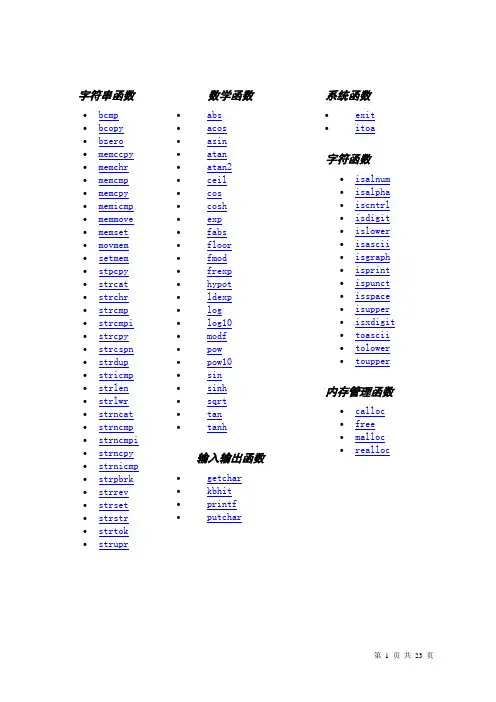
字符串函数∙bcmp∙bcopy∙bzero∙memccpy ∙memchr ∙memcmp ∙memcpy ∙memicmp ∙memmove ∙memset ∙movmem ∙setmem ∙stpcpy ∙strcat ∙strchr ∙strcmp ∙strcmpi ∙strcpy ∙strcspn ∙strdup ∙stricmp ∙strlen ∙strlwr ∙strncat ∙strncmp ∙strncmpi ∙strncpy ∙strnicmp ∙strpbrk ∙strrev ∙strset ∙strstr ∙strtok ∙strupr数学函数∙abs∙acos∙asin∙atan∙atan2∙ceil∙cos∙cosh∙exp∙fabs∙floor∙fmod∙frexp∙hypot∙ldexp∙log∙log10∙modf∙pow∙pow10∙sin∙sinh∙sqrt∙tan∙tanh输入输出函数∙getchar∙kbhit∙printf∙putchar系统函数∙exit∙itoa字符函数∙isalnum∙isalpha∙iscntrl∙isdigit∙islower∙isascii∙isgraph∙isprint∙ispunct∙isspace∙isupper∙isxdigit∙toascii∙tolower∙toupper内存管理函数∙calloc∙free∙malloc∙reallocctype.h 字符函数isalnum功能:判断字符c是否为字母或数字说明:当c为数字0-9或字母a-z及A-Z时,返回非零值,否则返回零。
举例:printf("%c:%s\n",c,isalnum(c)?"yes":"no");isalpha功能:判断字符c是否为英文字母说明:当c为英文字母a-z或A-Z时,返回非零值,否则返回零。
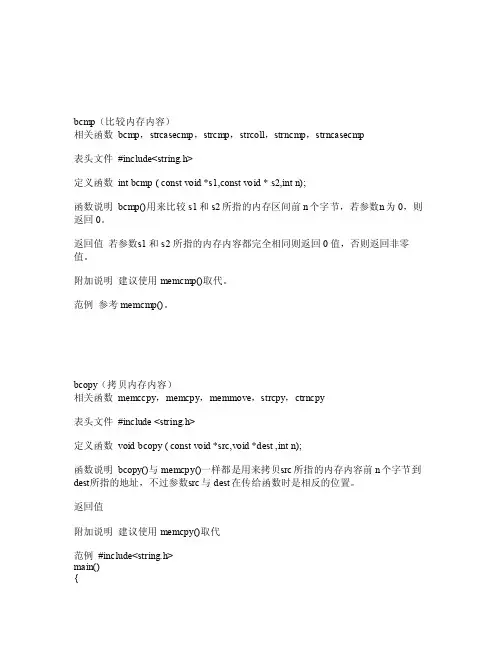
bc mp(比较内存内容)相关函数b cmp,s trcas ecmp,strcm p,str coll,strnc mp,st rncas ecmp表头文件 #i nclud e<str ing.h>定义函数int b cmp ( cons t voi d *s1,cons t voi d * s2,int n);函数说明 bc mp()用来比较s1和s2所指的内存区间前n个字节,若参数n为0,则返回0。
返回值若参数s1 和s2所指的内存内容都完全相同则返回0 值,否则返回非零值。
附加说明建议使用memc mp()取代。
范例参考memc mp()。
bco py(拷贝内存内容)相关函数m emccp y,mem cpy,m emmov e,str cpy,c trncp y表头文件#incl ude <strin g.h>定义函数 vo id bc opy ( cons t voi d *sr c,voi d *de st ,i nt n);函数说明bcopy()与me mcpy()一样都是用来拷贝s rc所指的内存内容前n个字节到dest所指的地址,不过参数s rc与de st在传给函数时是相反的位置。
返回值附加说明建议使用memc py()取代范例 #i nclud e<str ing.h>mai n(){char dest[30]=”stri ng(a)”;ch ar sr c[30]=”str ing\0strin g”;i nt i;bcop y(src,dest,30);/* sr c指针放在前*/p rintf(bcop y():“)fo r(i=0;i<30;i++)prin tf(“%c”,de st[i]);me mcpy(destsrc,30); /*dest指针放在钱*/pr intf(…\nme mcpy() : “);fo r(i=0;i<30;i++)prin tf(“%c”,de st[i]);执行b copy() : s tring stri ngme mcpy() :st ringsringbze ro(将一段内存内容全清为零)相关函数m emset,swab表头文件#inclu de<st ring.h>定义函数 void bzer o(voi d *s,int n);函数说明 bzer o()会将参数s所指的内存区域前n个字节,全部设为零值。
C语⾔⽂件操作函数⼤全(超详细)相关函数 open,fclose表头⽂件 #include<stdio.h>定义函数 FILE * fopen(const char * path,const char * mode);函数说明参数path字符串包含欲打开的⽂件路径及⽂件名,参数mode字符串则代表着流形态。
r 打开只读⽂件,该⽂件必须存在。
r+ 打开可读写的⽂件,该⽂件必须存在。
w 打开只写⽂件,若⽂件存在则⽂件长度清为0,即该⽂件内容会消失。
若⽂件不存在则建⽴该⽂件。
w+ 打开可读写⽂件,若⽂件存在则⽂件长度清为零,即该⽂件内容会消失。
若⽂件不存在则建⽴该⽂件。
a 以附加的⽅式打开只写⽂件。
若⽂件不存在,则会建⽴该⽂件,如果⽂件存在,写⼊的数据会被加到⽂件尾,即⽂件原先的内容会被保留。
a+ 以附加⽅式打开可读写的⽂件。
若⽂件不存在,则会建⽴该⽂件,如果⽂件存在,写⼊的数据会被加到⽂件尾后,即⽂件原先的内容会被保留。
复制代码代码如下:r Open text file for reading. The stream is positioned at the beginning of the file.r+ Open for reading and writing. The stream is positioned at the beginning of the file.w Truncate file to zero length or create text file for writing. The stream is positioned at the beginning of the file.w+ Open for reading and writing. The file is created if it does not exist, otherwise it is truncated. The stream is posi‐tioned at the beginning of the file.a Open for appending (writing at end of file). The file is created if it does not exist. The stream is positioned at theend of the file.a+ Open for reading and appending (writing at end of file). The file is created if it does not exist. The initial file posi‐tion for reading is at the beginning of the file, but output is always appended to the end of the file.上述的形态字符串都可以再加⼀个b字符,如rb、w+b或ab+等组合,加⼊b 字符⽤来告诉函数库打开的⽂件为⼆进制⽂件,⽽⾮纯⽂字⽂件。
c语言数学函数集C语言数学函数集在C语言中,数学函数是非常重要的一部分,它们提供了各种数学运算和计算的功能,可以帮助我们解决各种数学问题。
本文将介绍C语言中常用的数学函数集合,包括数值运算、三角函数、指数函数、对数函数等。
一、数值运算函数1. fabs函数:用于计算一个数的绝对值。
例如,fabs(-5)的返回值是5。
2. ceil函数:用于向上取整。
例如,ceil(4.3)的返回值是5。
3. floor函数:用于向下取整。
例如,floor(4.7)的返回值是4。
4. fmod函数:用于计算两个数的余数。
例如,fmod(10.5, 3)的返回值是1.5。
5. pow函数:用于计算一个数的幂。
例如,pow(2, 3)的返回值是8。
二、三角函数1. sin函数:用于计算一个角度的正弦值。
例如,sin(30)的返回值是0.5。
2. cos函数:用于计算一个角度的余弦值。
例如,cos(60)的返回值是0.5。
3. tan函数:用于计算一个角度的正切值。
例如,tan(45)的返回值是1。
4. asin函数:用于计算一个值的反正弦值。
例如,asin(0.5)的返回值是30。
5. acos函数:用于计算一个值的反余弦值。
例如,acos(0.5)的返回值是60。
三、指数函数和对数函数1. exp函数:用于计算一个数的指数值。
例如,exp(1)的返回值是2.71828。
2. log函数:用于计算一个数的自然对数值。
例如,log(10)的返回值是2.30259。
3. log10函数:用于计算一个数的以10为底的对数值。
例如,log10(100)的返回值是2。
四、其他数学函数1. sqrt函数:用于计算一个数的平方根。
例如,sqrt(16)的返回值是4。
2. rand函数:用于生成一个随机数。
例如,rand()的返回值是一个0到RAND_MAX之间的随机整数。
3. abs函数:用于计算一个整数的绝对值。
例如,abs(-5)的返回值是5。
C语⾔常⽤函数⼤全⼀、数学函数调⽤数学函数时,要求在源⽂件中包下以下命令⾏:#include <math.h>函数原型说明功能返回值说明int abs( int x)求整数x的绝对值计算结果double fabs(double x)求双精度实数x的绝对值计算结果double acos(double x)计算cos-1(x)的值计算结果x在-1~1范围内double asin(double x)计算sin-1(x)的值计算结果x在-1~1范围内double atan(double x)计算tan-1(x)的值计算结果double atan2(double x)计算tan-1(x/y)的值计算结果double cos(double x)计算cos(x)的值计算结果x的单位为弧度double cosh(double x)计算双曲余弦cosh(x)的值计算结果double exp(double x)求e x的值计算结果double fabs(double x)求双精度实数x的绝对值计算结果double floor(double x)求不⼤于双精度实数x的最⼤整数double fmod(double x,double y)求x/y整除后的双精度余数double frexp(double val,int *exp)把双精度val分解尾数和以2为底的指数n,即val=x*2n,n存放在exp所指的变量中返回位数x 0.5≤x<1double log(double x)求㏑x计算结果x>0 double log10(double x)求log10x计算结果x>0double modf(double val,double*ip)把双精度val分解成整数部分和⼩数部分,整数部分存放在ip所指的变量中返回⼩数部分double pow(double x,double y)计算x y的值计算结果double sin(double x)计算sin(x)的值计算结果x的单位为弧度double sinh(double x)计算x的双曲正弦函数sinh(x)的值计算结果double sqrt(double x)计算x的开⽅计算结果x≥0double tan(double x)计算tan(x)计算结果double tanh(double x)计算x的双曲正切函数tanh(x)的值计算结果⼆、字符函数调⽤字符函数时,要求在源⽂件中包下以下命令⾏:#include <ctype.h>函数原型说明功能返回值int isalnum(int ch)检查ch是否为字母或数字是,返回1;否则返回0int isalpha(int ch)检查ch是否为字母是,返回1;否则返回0int iscntrl(int ch)检查ch是否为控制字符是,返回1;否则返回0int isdigit(int ch)检查ch是否为数字是,返回1;否则返回0int isgraph(int ch)检查ch是否为ASCII码值在ox21到ox7e的可打印字符(即不包含空格字符)是,返回1;否则返回0int islower(int ch)检查ch是否为⼩写字母是,返回1;否则返回0int isprint(int ch)检查ch是否为包含空格符在内的可打印字符是,返回1;否则返回0int ispunct(int ch)检查ch是否为除了空格、字母、数字之外的可打印字符是,返回1;否则返回0int isspace(int ch)检查ch是否为空格、制表或换⾏符是,返回1;否则返回0int isupper(int ch)检查ch是否为⼤写字母是,返回1;否则返回0int isxdigit(int ch)检查ch是否为16进制数是,返回1;否则返回0int tolower(int ch)把ch中的字母转换成⼩写字母返回对应的⼩写字母int toupper(int ch)把ch中的字母转换成⼤写字母返回对应的⼤写字母三、字符串函数调⽤字符函数时,要求在源⽂件中包下以下命令⾏:#include <string.h>函数原型说明功能返回值char *strcat(char *s1,char *s2)把字符串s2接到s1后⾯s1所指地址char *strchr(char *s,int ch)在s所指字符串中,找出第⼀次出现字符ch的位置返回找到的字符的地址,找不到返回NULLint strcmp(char *s1,char *s2)对s1和s2所指字符串进⾏⽐较s1<s2,返回负数;s1= =s2,返回0;s1>s2,返回正数char *strcpy(char *s1,char *s2)把s2指向的串复制到s1指向的空间s1 所指地址unsigned strlen(char *s)求字符串s的长度返回串中字符(不计最后的'\0')个数char *strstr(char *s1,char *s2)在s1所指字符串中,找出字符串s2第⼀次出现的位置返回找到的字符串的地址,找不到返回NULL四、输⼊输出函数调⽤字符函数时,要求在源⽂件中包下以下命令⾏:#include <stdio.h>函数原型说明功能返回值void clearer(FILE *fp)清除与⽂件指针fp有关的所有出错信息⽆int fclose(FILE *fp)关闭fp所指的⽂件,释放⽂件缓冲区出错返回⾮0,否则返回0int feof (FILE *fp)检查⽂件是否结束遇⽂件结束返回⾮0,否则返回0int fgetc (FILE *fp)从fp所指的⽂件中取得下⼀个字符出错返回EOF,否则返回所读字符char *fgets(char *buf,int n, FILE *fp)从fp所指的⽂件中读取⼀个长度为n-1的字符串,将其存⼊buf所指存储区返回buf所指地址,若遇⽂件结束或出错返回NULLFILE *fopen(char *filename,char*mode)以mode指定的⽅式打开名为filename的⽂件成功,返回⽂件指针(⽂件信息区的起始地址),否则返回NULLint fprintf(FILE *fp, char *format, args,…)把args,…的值以format指定的格式输出到fp指定的⽂件中实际输出的字符数int fputc(char ch, FILE *fp)把ch中字符输出到fp指定的⽂件中成功返回该字符,否则返回EOFint fputs(char *str, FILE *fp)把str所指字符串输出到fp所指⽂件成功返回⾮负整数,否则返回-1(EOF)int fread(char *pt,unsigned size,unsigned n, FILE *fp)从fp所指⽂件中读取长度size为n个数据项存到pt所指⽂件读取的数据项个数int fscanf (FILE *fp, char *format,args,…)从fp所指的⽂件中按format指定的格式把输⼊数据存⼊到args,…所指的内存中已输⼊的数据个数,遇⽂件结束或出错返回0int fseek (FILE *fp,long offer,int base)移动fp所指⽂件的位置指针成功返回当前位置,否则返回⾮0long ftell (FILE *fp)求出fp所指⽂件当前的读写位置读写位置,出错返回 -1Lint fwrite(char *pt,unsignedsize,unsigned n, FILE *fp)把pt所指向的n*size个字节输⼊到fp所指⽂件输出的数据项个数int getc (FILE *fp)从fp所指⽂件中读取⼀个字符返回所读字符,若出错或⽂件结束返回EOF int getchar(void)从标准输⼊设备读取下⼀个字符返回所读字符,若出错或⽂件结束返回-1char *gets(char *s)从标准设备读取⼀⾏字符串放⼊s所指存储区,⽤’\0’替换读⼊的换⾏符返回s,出错返回NULLint printf(char *format,args,…)把args,…的值以format指定的格式输出到标准输出设备输出字符的个数int putc (int ch, FILE *fp)同fputc同fputcint putchar(char ch)把ch输出到标准输出设备返回输出的字符,若出错则返回EOFint puts(char *str)把str所指字符串输出到标准设备,将’\0’转成回车换⾏符返回换⾏符,若出错,返回EOFint rename(char *oldname,char*newname)把oldname所指⽂件名改为newname所指⽂件名成功返回0,出错返回-1void rewind(FILE *fp)将⽂件位置指针置于⽂件开头⽆int scanf(char *format,args,…)从标准输⼊设备按format指定的格式把输⼊数据存⼊到args,…所指的内存中已输⼊的数据的个数五、动态分配函数和随机函数调⽤字符函数时,要求在源⽂件中包下以下命令⾏:#include <stdlib.h>函数原型说明功能返回值void *calloc(unsigned n,unsignedsize)分配n个数据项的内存空间,每个数据项的⼤⼩为size个字节分配内存单元的起始地址;如不成功,返回0void *free(void *p)释放p所指的内存区⽆void *free(void *p)释放p所指的内存区⽆void *malloc(unsigned size)分配size个字节的存储空间分配内存空间的地址;如不成功,返回0 void *realloc(void *p,unsigned size)把p所指内存区的⼤⼩改为size个字节新分配内存空间的地址;如不成功,返回0int rand(void)产⽣0~32767的随机整数返回⼀个随机整数void exit(int state)程序终⽌执⾏,返回调⽤过程,state为0正常终⽌,⾮0⾮正⽆常终⽌。
C语言函数大全(m开头)main()主函数每一C程序都必须有一m ain()函数, 可以根据自己的爱好把它放在程序的某个地方。
有些程序员把它放在最前面, 而另一些程序员把它放在最后面, 无论放在哪个地方, 以下几点说明都是适合的。
1.main()参数在Turbo C2.0启动过程中, 传递main()函数三个参数: argc, argv和e nv。
* argc: 整数, 为传给mai n()的命令行参数个数。
* argv: 字符串数组。
在DOS 3.X 版本中, argv[0] 为程序运行的全路径名;对DOS 3.0以下的版本, argv[0]为空串("") 。
argv[1] 为在DOS命令行中执行程序名后的第一个字符串;argv[2] 为执行程序名后的第二个字符串;...argv[argc]为NULL。
*env: 安符串数组。
env[] 的每一个元素都包含EN VVAR=value形式的字符串。
其中ENVV AR为环境变量如PA TH或87。
value为ENVVA R的对应值如C:\DOS, C:\TURBOC(对于PATH) 或YES(对于87)。
TurboC2.0启动时总是把这三个参数传递给m ain()函数, 可以在用户程序中说明(或不说明)它们, 如果说明了部分(或全部)参数, 它们就成为m ain()子程序的局部变量。
请注意: 一旦想说明这些参数, 则必须按ar gc, argv, env 的顺序, 如以下的例子:main()main(int argc)main(int argc, char *argv[])main(int argc, char *argv[], char *env[])其中第二种情况是合法的, 但不常见, 因为在程序中很少有只用argc,而不用argv[]的情况。
c语言m的代码
在 C 语言中,你可以使用以下代码来表示变量 m:
```c
int m;
```
在上述代码中,`int` 是一种整数类型,用于存储整数值。
你可以根据需要修改 `int` 为其他整数类型(如 `short`、`long` 等)或浮点数类型(如 `float`、`double` 等),以满足你对变量 m 的数据类型需求。
你还可以对变量 m 进行赋值、计算等操作,例如:
```c
int m = 5; // 将整数 5 赋值给变量 m
m = m + 1; // 将变量 m 的值加 1
```
此外,你可以根据具体的编程需求和逻辑,在代码中使用变量 m。
请注意,C 语言中的变量命名需要遵循一定的规范,变量名可以由字母、数字和下划线组成,但不能以数字开头。
希望以上示例对你有所帮助!如果你还有其他问题,请随时提问。
C语言函数大全(m开头)
main()主函数
每一C 程序都必须有一 main() 函数, 可以根据自己的爱好把它放在程序的某
个地方。
有些程序员把它放在最前面, 而另一些程序员把它放在最后面, 无论放
在哪个地方, 以下几点说明都是适合的。
1. main() 参数
在Turbo C2.0启动过程中, 传递main()函数三个参数: argc, argv和env。
* argc: 整数, 为传给main()的命令行参数个数。
* argv: 字符串数组。
在DOS 3.X 版本中, argv[0] 为程序运行的全路径名; 对DOS 3.0
以下的版本, argv[0]为空串("") 。
argv[1] 为在DOS命令行中执行程序名后的第一个字符串;
argv[2] 为执行程序名后的第二个字符串;
...
argv[argc]为NULL。
*env: 安符串数组。
env[] 的每一个元素都包含ENVVAR=value形式的字符
串。
其中ENVVAR为环境变量如PATH或87。
value 为ENVVAR的对应值如C:\DOS, C: \TURBOC(对于PATH) 或YES(对于87)。
Turbo C2.0启动时总是把这三个参数传递给main()函数, 可以在用户程序中
说明(或不说明)它们, 如果说明了部分(或全部)参数, 它们就成为main()子程序
的局部变量。
请注意: 一旦想说明这些参数, 则必须按argc, argv, env 的顺序, 如以下
的例子:
main()
main(int argc)
main(int argc, char *argv[])
main(int argc, char *argv[], char *env[])
其中第二种情况是合法的, 但不常见, 因为在程序中很少有只用argc, 而不
用argv[]的情况。
以下提供一样例程序EXAMPLE.EXE, 演示如何在main()函数中使用三个参数: /*program name EXAMPLE.EXE*/
#include
#include
main(int argc, char *argv[], char *env[])
{
int i;
printf("These are the %d command- line arguments passed to
main:\n\n", argc);
for(i=0; i<=argc; i++)
printf("argv[%d]:%s\n", i, argv[i]);
printf("\nThe environment string(s)on this system are:\n\n");
for(i=0; env[i]!=NULL; i++)
printf(" env[%d]:%s\n", i, env[i]);
}
如果在DOS 提示符下, 按以下方式运行EXAMPLE.EXE:
C:\example first_argument "argument with blanks" 3 4 "last but one" stop!
注意: 可以用双引号括起内含空格的参数, 如本例中的: " argument
with blanks"和"Last but one")。
结果是这样的:
The value of argc is 7
These are the 7 command-linearguments passed to main:
argv[0]:C:\TURBO\EXAMPLE.EXE
argv[1]:first_argument
argv[2]:argument with blanks
argv[3]:3
argv[4]:4
argv[5]:last but one
argv[6]:stop!
argv[7]:(NULL)
The environment string(s) on this system are:
env[0]: COMSPEC=C:\
env[1]: PROMPT=$P$G /*视具体设置而定*/
env[2]: PATH=C:\DOS;C:\TC /*视具体设置而定*/
应该提醒的是: 传送main() 函数的命令行参数的长度为128 个字符 (包括参数间的空格), 这是由DOS 限制的。
函数名: matherr
功能: 用户可修改的数学错误处理程序
用法: int matherr(struct exception *e);
程序例:
/* This is a user-defined matherr function that prevents
any error messages from being printed. */
#include
int matherr(struct exception *a)
{
return 1;
}。